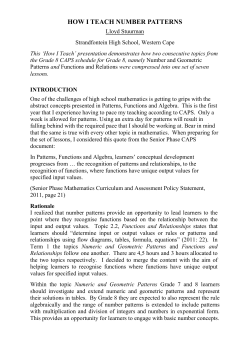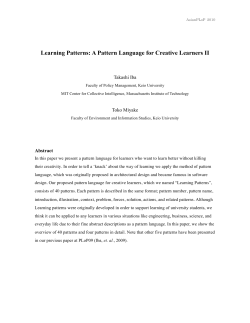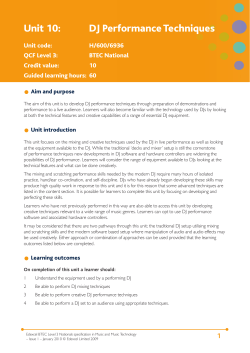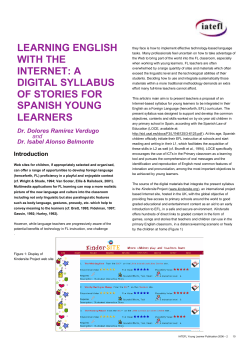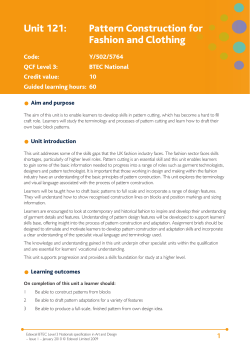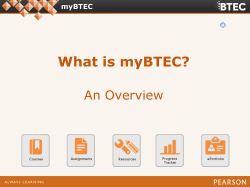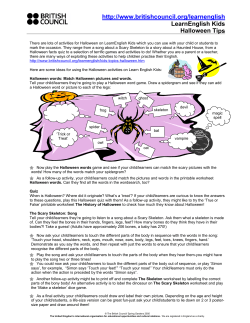
Unit 4: Aural Perception Skills Unit code: A/600/7011
Unit 4: Aural Perception Skills Unit code: A/600/7011 QCF Level 3: BTEC National Credit value: 10 Guided learning hours: 60 Aim and purpose The aim of this unit is to help learners develop a critical ear and knowledge about melodic parts, harmonic progressions, rhythms and texture. Unit introduction All musicians, whatever stage of the musical journey they are involved with, would benefit from this unit. Aural perception skills are fundamental to success for all types of musicians. Studying this unit involves listening to many different types of music and learning how to describe individual parts and the effects created by the combination of these parts. Learners will develop the skills needed to analyse a piece of music, recognising the different elements involved and the different textures created by a variety of types of instrumentation. Learners will listen to many different kinds of music during the study of this unit. Performers, composers, engineers and producers working professionally need good aural perception skills. They need to be able to hear the musical elements, so that they can comment constructively. Performers need to be able to listen critically to rehearse effectively. Composers and producers need to hone their awareness of part writing, rhythm, instrumental timbre and texture. Engineers would benefit tremendously from being able to communicate with performers using a common musical language. Learning outcomes On completion of this unit a learner should: 1 Know about different intervals and pitches 2 Know about chords and chord progressions 3 Know about simple and complex rhythms 4 Know about harmony and tonality. Edexcel BTEC Level 3 Nationals specification in Music and Music Technology – Issue 3 – September 2011 © Pearson Education Limited 2011 1 Unit content 1 Know about different intervals and pitches Intervals: major; minor; perfect; augmented; diminished; simple; compound Pitches: tones; semi-tones; degrees of the scale 2 Know about chords and chord progressions Types of chord: major; minor; dominant; augmented; diminished; seventh chords Chord progressions: standard progressions in both diatonic and chromatic forms 3 Know about simple and complex rhythms Time signatures: duple; triple; compound; complex eg 7/8 Rhythms: regular; dotted; syncopated; triplets; subdivisions eg 2+2+3 in 7/8 4 Know about harmony and tonality Harmony: diatonic harmony; chromatic harmony; modulation; resolution Tonality: tonal; atonality; bitonality; polytonality 2 Edexcel BTEC Level 3 Nationals specification in Music and Music Technology – Issue 3 – September 2011 © Pearson Education Limited 2011 Assessment and grading criteria In order to pass this unit, the evidence that the learner presents for assessment needs to demonstrate that they can meet all the learning outcomes for the unit. The assessment criteria for a pass grade describe the level of achievement required to pass this unit. Assessment and grading criteria To achieve a pass grade the evidence must show that the learner is able to: To achieve a merit grade the evidence must show that, in addition to the pass criteria, the learner is able to: To achieve a distinction grade the evidence must show that, in addition to the pass and merit criteria, the learner is able to: P1 identify, in a variety of types of music, simple intervals and pitches [IE, RL] M1 describe, in a variety of types of music, simple intervals and pitches D1 explain, in a variety of types of music, simple intervals and pitches P2 identify, in a variety of types of music, simple chords and chord progressions [IE, RL] M2 describe, in a variety of types of music, simple chords and chord progressions D2 explain, in a variety of types of music, simple chords and chord progressions P3 M3 describe, in a variety of types D3 identify, in a variety of types of music, simple and complex of music, simple and complex rhythms rhythms P4 identify the harmony and tonality used in a variety of types of music. [IE, RL] M4 describe the harmony and tonality used in a variety of types of music. D4 explain, in a variety of types of music, simple and complex rhythms explain the harmony and tonality used in a variety of types of music. PLTS: This summary references where applicable, in the square brackets, the elements of the personal, learning and thinking skills applicable in the pass criteria. It identifies opportunities for learners to demonstrate effective application of the referenced elements of the skills. Key IE – independent enquirers RL – reflective learners SM – self-managers CT – creative thinkers TW – team workers EP – effective participators Edexcel BTEC Level 3 Nationals specification in Music and Music Technology – Issue 3 – September 2011 © Pearson Education Limited 2011 3 Essential guidance for tutors Delivery This unit is designed to be flexible, lending itself to a variety of different delivery methods depending on the abilities of the learner group. However, in all cases the use of recordings is paramount, putting any classroom exercises or examples in the wider context of established compositions. Tutors will need to give learners examples of the different elements of music. Where possible, examples should aim to cover a range of types and styles of music. This will allow learners to hear the parts, chords, rhythms, instruments and textures in a number of ways and will prevent them from developing ‘blanket’ associations. Learners may find some of the ideas and concepts in this unit daunting at first and difficult to understand; notating a full chord sequence across an entire song, for example, may seem impossible. However, being introduced to key ideas in small doses could encourage learners; they should begin to feel more comfortable with the concepts. Breaking the unit down into simple tasks will allow learners to gradually acquire the vocabulary associated with aural skills provided in the unit content. Learners will enjoy this unit most if they are actively involved. One method could be giving them the opportunity to play some of the examples. Composers should be allowed an opportunity to include special features of parts, chords and rhythms studied in their own compositions. Learners could work in groups to recreate a track from a CD. The important aspect here is that they are encouraged to do this through using their ears only, rather than finding the score of MIDI files from the internet. Having completed this task, they would then be able to describe what they have heard and recreated. Working with the elements rather than simply describing them without active and physical involvement will allow learners to have far superior recognition skills. Alternatively, tutors may provide learners with a piece of music that is simple and clear enough to lend itself to analysis. If set at the right level, learners may be able to produce a piece of work that describes exactly where in the piece the different elements can be found. This could be done through an analysis essay or by a viva voce. Another option would be for learners to pick a piece of music of their choice and present it to their peers, pointing out where different elements appear. If these approaches are taken, tutors may need to offer some guidance to learners to ensure that they select pieces that provide the scope for them to demonstrate their understanding of the different features. A mixture of the delivery methods outlined above may, in the end, be the most suitable approach. 4 Edexcel BTEC Level 3 Nationals specification in Music and Music Technology – Issue 3 – September 2011 © Pearson Education Limited 2011 Outline learning plan The outline learning plan has been included in this unit as guidance and can be used in conjunction with the programme of suggested assignments. The outline learning plan demonstrates one way in planning the delivery and assessment of this unit. Topic and suggested assignments/activities and/assessment Introduction to the unit – whole class. ● Introduce learners to the unit content and grading criteria. Elements of music: melody, harmony, rhythm, instrumentation, texture, timbre. Analysis of full songs and instrumental pieces to develop a critical ear. ● Parts: develop awareness of voices and the relationships between them. ● Harmony: horizontal movement in addition to the vertical consequences. ● Rhythm: how rhythms are created by the interaction of parts. Simple part analysis and exercises. ● Learners are asked to notate, sing back or perform simple parts from a recording or performance. ● Learners are asked to describe those parts. ● Part identification from a score where learners identify a given part from a score. Simple harmony analysis and exercises. ● Learners are asked to recognise and notate simple chords and progressions. ● Learners are asked to describe those chords. Simple rhythm analysis and exercises. ● Clapping exercises where learners clap back simple parts played by the tutor. ● Notation exercises where learners notate simple rhythms. ● Learners are asked to describe those rhythms. Assignment 1: The Elements of Music – P1, M1, D1, P2, M2, D2, P3, M3, D3 Describe a piece of music containing simple parts, harmonic progressions and rhythms. Assignment overview: ● group or solo rehearsals of pieces containing examples of the above ● tutor to choose pieces and ideally offer learners a choice ● composers would be given the option to compose a piece containing a list of musical features given to them by the tutor. Feedback. Complex part analysis and exercises. ● Learners are asked to notate, sing back or perform complex parts from a recording or performance. ● Part identification from a score where learners identify a given part from a score. Complex harmony analysis and exercises. ● Chord recognition and notation of complex chords and progressions. Complex rhythm analysis and exercises. ● Clapping exercises where learners clap back complex parts played by the tutor. ● Notation exercises where learners notate complex rhythms. Edexcel BTEC Level 3 Nationals specification in Music and Music Technology – Issue 3 – September 2011 © Pearson Education Limited 2011 5 Topic and suggested assignments/activities and/assessment Assignment 2: Adding Interest – P1, M1, D1, P2, M2, D2, P3, M3, D3 Describe and perform or compose a piece of music containing complex parts, harmonic progressions and rhythms. ● Group or solo rehearsals of pieces containing examples of the above. ● Tutor to choose pieces and ideally offer learners a choice. Feedback. Assignment 3: Analysing Harmonic Language – P4, M4, D4 Analysis of the harmonic language produced in a variety of pieces of music. ● Learners to identify the tonalities in each piece of music (P4). ● Describe the composer’s intention (M4). ● Compare harmonic and tonal solutions and responses and comment critically on the similarities and differences (D4). Feedback. Assessment Learners should be encouraged to use a variety of methods to gather and develop skills for this unit. In the initial stages, traditional aural tests may be used in which learners show they are able to recognise intervals, chords and rhythms. This could be done using manuscript or music technology, but whatever the means, formative assessment will be valuable to gauge the current skill base of the group. The tutor will need to ensure that learners make a connection between what they are playing and the means to communicate it. It is imperative that learners focus not only on the performance qualities of a piece of music but that they are confident about describing its components. A significant element of the teaching should revolve around basic terminology for learners to use for evidence of understanding. Learner’s understanding in relation to reproducing complex elements of music would be best assessed if the tutor asks them to choose parts of the piece to play as examples of certain features. For instance, a tutor may ask a performer(s) to select a part of the piece that uses syncopation and perform that section in isolation. This also avoids the need for learners to write commentaries, and assessment can be more efficient in a ‘live’ response to questions recorded on video. If learners respond well to formative assessment of their ability to recognise and describe simple components then the tutor could attempt Assignment 2 straight away. This assignment can be repeated to offer learners further opportunities to cover the distinction criteria. Learning outcomes 1, 2 and 3 can be evidenced by written or oral descriptions of pieces of music that learners can perform. The advantage here is that learners would have an in-depth knowledge of the piece and a familiarity that cannot be emulated with a test. This could take the form of a set of questions that the learner finds the answers to within the piece of music. These answers can then be delivered in written form or as a viva voce after their performances. Alternatively, composers can be given a list of musical features that they should include in a composition. Learning outcome 4 can be evidenced by an analysis of a number of pieces of music. Tutors should select these carefully, and consider offering a choice of pieces of music to address differentiation across the learner group. Choice should also reflect variety in terms of genre, perhaps covering styles that so far have not been covered in the first two assignments. This will ensure that learners have been exposed to a wide variety of different types of music during their study and that they have had a genuine opportunity to become more aware of different types of instrumentation. 6 Edexcel BTEC Level 3 Nationals specification in Music and Music Technology – Issue 3 – September 2011 © Pearson Education Limited 2011 To achieve P1, learners should identify each of the fundamental parts within the ensemble. This description should cover the names of the instruments or voices describing their range, role and the simple nature of the line that the part produces. Learners can be asked to produce a document in response to written questions or respond to direct questions. To achieve M1, learners will be able to describe the intervals and ensure that there is an understanding behind the choice of identification. To achieve D1, learners should explain their identification, illustrating the thought processes behind the choice and ensuring that the identification is grounded in a solid understanding of intervals and pitch. To achieve P2, learners should identify simple harmonic features within a piece of music. They should be able to describe its tonality, key and simple chord progressions. To achieve M2, learners should describe the harmonic features within a piece of music, going beyond simple labels and quick answers. They should be able to show how the identification has been arrived at. They should be able to describe diminished, augmented and extended chords. To achieve D2, learners should explain chords and chord progressions and be able to show the thought processes behind the music and the choices made. To achieve P3, learners should identify simple and compound rhythms and time signatures within a piece of music, eg dotted, syncopation, duple and triple time. To achieve M3, learners should be able to go further than labelling and be able to show some further understanding of the description made. Learners should be more secure with compound time signatures, eg 12/8 and complex rhythms, eg triplets and subdivisions within complex time signatures. To achieve D3, learners should explain the thought processes behind the rhythms and time signatures used, showing how they are developed and deployed. To achieve P4, learners need to identify the harmonic and tonal make-up of given pieces of music. This should be detailed, and not rely on simplistic statements like ‘in C’. Harmony should be described in terms of key, modulation and progression and where possible go beyond basic ‘major’ and ‘minor’ labels. To achieve M4, learners need to describe the effect of harmonic and tonal interest in the piece. For example, they may highlight the way tonal shifts add colour or indicate cultural references as used in Klezmer or Asian music. Learner will here explain more about the composer’s intentions and how they have been realised and secured in the harmony. To achieve D4, learners need to get inside the music and give a detailed explanation of tonality created by composers in a variety of pieces of music. For this reason, the tutor needs to offer a number of pieces of music to learners to enable them to make comparisons. Edexcel BTEC Level 3 Nationals specification in Music and Music Technology – Issue 3 – September 2011 © Pearson Education Limited 2011 7 Programme of suggested assignments The table below shows a programme of suggested assignments that cover the pass, merit and distinction criteria in the assessment and grading grid. This is for guidance and it is recommended that centres either write their own assignments or adapt any Edexcel assignments to meet local needs and resources. Criteria covered Assignment title Scenario P1, M1, D1 The Elements of Music Preparation for interviews, or for teaching skills as an instrumental teacher. P2, M2, D2 P3, M3, D3 P1, M1, D1 Adding Interest P2, M2, D2 P3, M3, D3 P4, M4, D4 Analysing Harmonic Language Assessment method Preparation for interviews, or for teaching skills as an instrumental teacher. Writing an article for a music magazine, eg BBC Music magazine or Gramophone. ● ● ● ● ● Oral or written response to questions. Performance of sections as a response to questions. Oral or written response to questions. Performance of sections as a response to questions. Written piece of work. Links to National Occupational Standards, other BTEC units, other BTEC qualifications and other relevant units and qualifications This unit forms part of the BTEC Music and Music Technology sector suite. This unit has particular links with the following unit titles in the BTEC Music and Music Technology suite: Level 1 Level 2 Level 3 Solo Musical Performance Composing Music Exploring Musical Composition Listening Skills for Technologist Working as a Musical Ensemble Music Theory and Harmony The Development of Music Working and Developing as a Musical Ensemble Essential resources Indicative reading for learners Textbooks Adler S – The Study of Orchestration (W W Norton & Co, 2002) ISBN 9780393975727 Bowman D and Terry P – Aural Matters (Schott, 1995) ISBN 9780946535224 Taylor E – The AB Guide to Music Theory (ABRSM, 1991) ISBN 9781854724472 8 Edexcel BTEC Level 3 Nationals specification in Music and Music Technology – Issue 3 – September 2011 © Pearson Education Limited 2011 Delivery of personal, learning and thinking skills The table below identifies the opportunities for personal, learning and thinking skills (PLTS) that have been included within the pass assessment criteria of this unit. Skill When learners are … Independent enquirers analysing texture and comparing the use of texture in a number of recordings Reflective learners amending work after feedback from formative assessment considering the harmonic language used by others. Although PLTS are identified within this unit as an inherent part of the assessment criteria, there are further opportunities to develop a range of PLTS through various approaches to teaching and learning. Skill When learners are … Independent enquirers finding their own pieces that are suitable for use in assessment Creative thinkers adapting existing pieces of music to include features listed in the grading criteria developing their own compositions in response to a brief Reflective learners considering how their approach and preparation for assessment can be improved for the next assignment Team workers practising pieces of music as a group in preparation for assessment Self-managers as solo performers and composers preparing for assessment Effective participators rehearsing pieces in preparation for assessment. Edexcel BTEC Level 3 Nationals specification in Music and Music Technology – Issue 3 – September 2011 © Pearson Education Limited 2011 9 Functional Skills – Level 2 Skill When learners are … English Writing – write documents, including extended writing pieces, communicating information, ideas and opinions, effectively and persuasively 10 analysing and comparing textures form a number of pieces of music. Edexcel BTEC Level 3 Nationals specification in Music and Music Technology – Issue 3 – September 2011 © Pearson Education Limited 2011
© Copyright 2025

